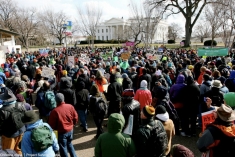WRR Commentary: From the Technical to the Fundamental
Commentary: March 2013 World Rivers Review
On February 17 I joined some 40,000 others in Washington, DC for the “Forward on Climate” rally – the largest mobilization on US climate change policy in history. International Rivers joined more than 130 groups that came together to call upon President Obama to reject the Keystone XL pipeline, a project that would allow TransCanada to expand its exploitation of dirty Alberta tar sands oil. The rally shows the climate movement in the US is hitting a new stride.
Less than two weeks later, the State Department – the permitting agencies for the trans-boundary project – issued its Supplemental Environmental Impact Statement that says the Keystone XL project is “unlikely to have a substantial impact” to local environments or the climate. Now US climate activists will be forced into the narrow confines of countering the data and refuting the conclusions of a technical project document rather than focusing on the fundamental changes that are required to avert climate chaos.
Such outcomes from technical environmental reviews are commonplace in the US, and widespread in planning for big dams throughout the global south. This issue of World Rivers Review takes an insider’s look at the flawed process of environmental and social impact assessments (ESIAs) – the primary instrument that dam builders complete to gain financing and approval for their projects. If river advocates can better understand the limitations of ESIAs, we’ll be better positioned to develop complementary strategies that keep the focus on the essentials we’re fighting for: living rivers as a condition for prosperity on Earth.
Our experience shows that ESIAs force community advocates into a technical decision-making frame that does not allow us to argue from a moral, ethical or spiritual standpoint. In their specificity about individual projects, ESIAs do not allow us to ask the more fundamental questions: Whose interests are prompting megadams? What type of economic development does a community aspire to? What is the full range of alternative options for investing in community infrastructure? Who will pay for the ongoing damage caused by a big dam? For civil society groups in most nations, there is no forum for addressing questions of this nature and scope. But there ought to be.
Neither are ESIAs the right tool for understanding the cumulative impacts of dam projects within a river basin—indeed, the negative consequences of a completed dam project will serve as the new “baseline conditions” for evaluating the impacts of a new dam.
This is not a cry to abandon community advocacy in ESIA processes—on the contrary, we must continue to seek broad reforms to the process (some of which are articulated in these pages of WRR) as well as stridently argue for the voiceless in this process – the environment and affected communities – and engage in the data-driven and technical battles of project-specific ESIAs. Otherwise, rivers and river-dependent communities will get next to nothing when a large dam scheme shows up uninvited. Yet we should reserve some of our scarce resources and campaigning energy to develop strategies that can lift our issues above the technical and into the fundamental.
Rather than sacrificing whole river basins from the “death by a thousand cuts” as each new dam comes along, we must continue to work “upstream” on the root drivers of the large-dam economic model. Our interests in protecting rivers and river-based livelihoods for future generations would be better served if we turned the ESIA paradigm on its head. Instead of affected communities being asked how much damage is acceptable from Mega Project X, affected communities and their allies should be asking the heads of government: Within an entire river system, are their any values or functions worth protecting in perpetuity? Have you identified and assessed these river-derived services? What legal frameworks exist to ensure river values are protected? Are you exercising diplomatic leadership in trans-boundary river planning and protection?
International Rivers and our partners have begun to frame these questions in the Zambezi Basin by putting proposed large hydropower dams into the context of long-term climate and financial risks. In the Amazon, we’re challenging the legality of the energy agreement between Peru and Brazil for failing to assess cumulative impacts of proposed dams in the Peruvian Amazon.
We will continue to champion reform of the failing ESIA process, yet we’ll also keep our sights upstream to ensure public dialogue about the river crisis is brought up to the level and scope that it deserves.



